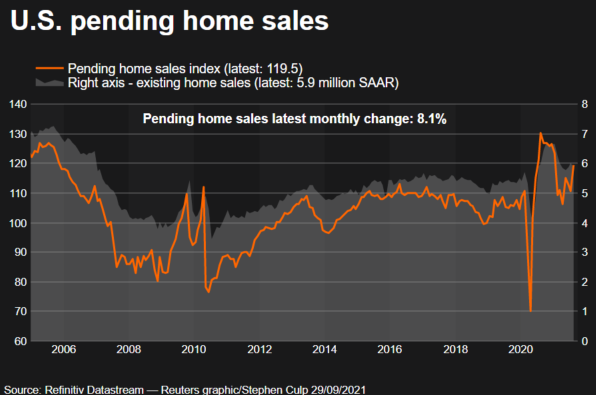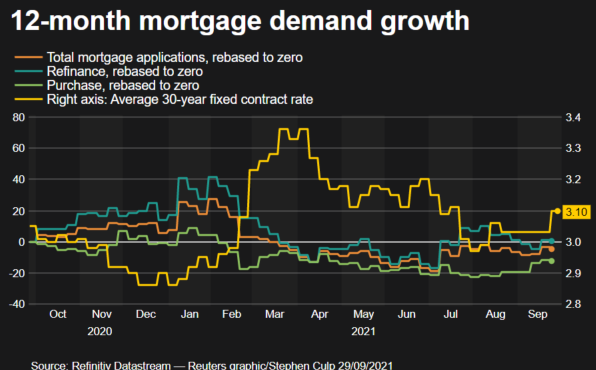Key Highlights
- Existing-home sales sagged for the eighth consecutive month to a seasonally adjusted annual rate of 4.71 million. Sales slipped 1.5% from August and 23.8% from the previous year.
- The median existing-home sales price increased to $384,800, up 8.4% from one year ago.
- The inventory of unsold existing homes declined for the second straight month to 1.25 million by the end of September, or the equivalent of 3.2 months’ supply at the current monthly sales pace.
Existing-home sales descended in September, the eighth month in a row of declines, according to the National Association of Realtors®. Three out of the four major U.S. regions notched month-over-month sales contractions, while the West held steady. On a year-over-year basis, sales dropped in all regions.
Total existing-home sales,[i] https://www.nar.realtor/existing-home-sales, completed transactions that include single-family homes, townhomes, condominiums and co-ops, retracted 1.5% from August to a seasonally adjusted annual rate of 4.71 million in September. Year-over-year, sales waned by 23.8% (down from 6.18 million in September 2021).
“The housing sector continues to undergo an adjustment due to the continuous rise in interest rates, which eclipsed 6% for 30-year fixed mortgages in September and are now approaching 7%,” said NAR Chief Economist Lawrence Yun. “Expensive regions of the country are especially feeling the pinch and seeing larger declines in sales.”
Total housing inventory[ii] registered at the end of September was 1.25 million units, which was down 2.3% from August and 0.8% from the previous year. Unsold inventory sits at a 3.2-month supply at the current sales pace – unchanged from August and up from 2.4 months in September 2021.
“Despite weaker sales, multiple offers are still occurring with more than a quarter of homes selling above list price due to limited inventory,” Yun added. “The current lack of supply underscores the vast contrast with the previous major market downturn from 2008 to 2010, when inventory levels were four times higher than they are today.”
The median existing-home price[iii] for all housing types in September was $384,800, an 8.4% jump from September 2021 ($355,100), as prices climbed in all regions. This marks 127 consecutive months of year-over-year increases, the longest-running streak on record. It was the third month in a row, however, that the median sales price faded after reaching a record high of $413,800 in June, the usual seasonal trend of prices trailing off after peaking in the early summer.
Properties typically remained on the market for 19 days in September, up from 16 days in August and 17 days in September 2021. Seventy percent of homes sold in September 2022 were on the market for less than a month.
First-time buyers were responsible for 29% of sales in September, unchanged from August 2022 and slightly higher than 28% from September 2021. NAR’s 2021 Profile of Home Buyers and Sellers – released in late 2021[iv] – found that the annual share of first-time buyers was 34%.
All-cash sales accounted for 22% of transactions in September, down from 24% in August and 23% in September 2021.
Individual investors or second-home buyers, who make up many cash sales, purchased 15% of homes in September, down from 16% in August, but up from 13% in September 2021.
Distressed sales[v] – foreclosures and short sales – represented 2% of sales in September, a marginal increase from 1% in August 2022 and September 2021.
According to Freddie Mac, the average commitment rate for a 30-year, conventional, fixed-rate mortgage was 6.11% in September, up from 5.22% in August. The average commitment rate across all of 2021 was 2.96%.
Realtor.com®’s Market Trends Report in September shows that the largest year-over-year median list price growth occurred in Miami (+28.3%), Memphis (+27.3%) and Milwaukee (+27.0%). Phoenix reported the highest increase in the share of homes that had their prices reduced compared to last year (+32.3 percentage points), followed by Austin (+27.4 percentage points) and Las Vegas (+20.0 percentage points).
Single-family and Condo/Co-op Sales
Single-family home sales declined to a seasonally adjusted annual rate of 4.22 million in September, down 0.9% from 4.26 million in August and down 23.0% from the previous year. The median existing single-family home price was $391,000 in September, up 8.1% from September 2021.
Existing condominium and co-op sales were recorded at a seasonally adjusted annual rate of 490,000 units in September, down 5.8% from August and 30.0% from one year ago. The median existing condo price was $331,700 in September, an annual increase of 9.8%.
“Buying or selling a home involves a series of requirements and variables, and it’s important to have someone in your corner from start to finish to make the process as smooth as possible,” said NAR President Leslie Rouda Smith, a Realtor® from Plano, Texas, and a broker associate at Dave Perry-Miller Real Estate in Dallas. “Realtors® rely on in-depth knowledge of the market and objectivity to deliver trusted expertise to consumers in every U.S. ZIP code.”
Regional Breakdown
Existing-home sales in the Northeast dwindled 1.6% from August to an annual rate of 610,000 in September, retreating 18.7% from September 2021. The median price in the Northeast was $418,500, an increase of 8.3% from one year ago.
Existing-home sales in the Midwest slid 1.7% from the previous month to an annual rate of 1,140,000 in September, falling 19.7% from September 2021. The median price in the Midwest was $281,500, up 6.9% from the prior year.
In the South, existing-home sales pulled back 1.9% in September from August to an annual rate of 2,080,000, a decline of 23.8% from this time last year. The median price in the South was $351,700, an increase of 11.8% from September 2021.
Existing-home sales in the West were identical to last month at an annual rate of 880,000 in September, but down 31.3% from one year ago. The median price in the West was $595,400, a 7.1% increase from September 2021.
The National Association of Realtors® is America’s largest trade association, representing more than 1.5 million members involved in all aspects of the residential and commercial real estate industries.
# # #
For local information, please contact the local association of Realtors® for data from local multiple listing services (MLS). Local MLS data is the most accurate source of sales and price information in specific areas, although there may be differences in reporting methodology.
NOTE: NAR’s Pending Home Sales Index for September is scheduled for release on October 28, and Existing-Home Sales for October will be released on November 18. Release times are 10 a.m. Eastern.
Information about NAR is available at nar.realtor. This and other news releases are posted in the newsroom at nar.realtor/newsroom. Statistical data in this release, as well as other tables and surveys, are posted in the “Research and Statistics” tab.
[i] Existing-home sales, which include single-family, townhomes, condominiums and co-ops, are based on transaction closings from Multiple Listing Services. Changes in sales trends outside of MLSs are not captured in the monthly series. NAR benchmarks home sales periodically using other sources to assess overall home sales trends, including sales not reported by MLSs.
Existing-home sales, based on closings, differ from the U.S. Census Bureau’s series on new single-family home sales, which are based on contracts or the acceptance of a deposit. Because of these differences, it is not uncommon for each series to move in different directions in the same month. In addition, existing-home sales, which account for more than 90% of total home sales, are based on a much larger data sample – about 40% of multiple listing service data each month – and typically are not subject to large prior-month revisions.
The annual rate for a particular month represents what the total number of actual sales for a year would be if the relative pace for that month were maintained for 12 consecutive months. Seasonally adjusted annual rates are used in reporting monthly data to factor out seasonal variations in resale activity. For example, home sales volume is normally higher in the summer than in the winter, primarily because of differences in the weather and family buying patterns. However, seasonal factors cannot compensate for abnormal weather patterns.
Single-family data collection began monthly in 1968, while condo data collection began quarterly in 1981; the series were combined in 1999 when monthly collection of condo data began. Prior to this period, single-family homes accounted for more than nine out of 10 purchases. Historic comparisons for total home sales prior to 1999 are based on monthly single-family sales, combined with the corresponding quarterly sales rate for condos.
[ii] Total inventory and month’s supply data are available back through 1999, while single-family inventory and month’s supply are available back to 1982 (prior to 1999, single-family sales accounted for more than 90% of transactions and condos were measured only on a quarterly basis).
[iii] The median price is where half sold for more and half sold for less; medians are more typical of market conditions than average prices, which are skewed higher by a relatively small share of upper-end transactions. The only valid comparisons for median prices are with the same period a year earlier due to seasonality in buying patterns. Month-to-month comparisons do not compensate for seasonal changes, especially for the timing of family buying patterns. Changes in the composition of sales can distort median price data. Year-ago median and mean prices sometimes are revised in an automated process if additional data is received.
The national median condo/co-op price often is higher than the median single-family home price because condos are concentrated in higher-cost housing markets. However, in a given area, single-family homes typically sell for more than condos as seen in NAR’s quarterly metro area price reports.
[iv] Survey results represent owner-occupants and differ from separately reported monthly findings from NAR’s Realtors® Confidence Index, which include all types of buyers. The annual study only represents primary residence purchases, and does not include investor and vacation home buyers. Results include both new and existing homes.
[v] Distressed sales (foreclosures and short sales), days on market, first-time buyers, all-cash transactions and investors are from a monthly survey for the NAR’s Realtors® Confidence Index, posted at nar.realtor.
read more…
globenewswire.com/






